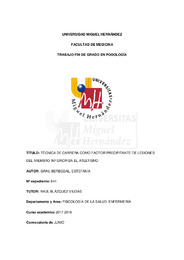Por favor, use este identificador para citar o enlazar este ítem:
https://hdl.handle.net/11000/25917Registro completo de metadatos
| Campo DC | Valor | Lengua/Idioma |
|---|---|---|
| dc.contributor.advisor | Blázquez Viudas, Raúl | - |
| dc.contributor.author | Grau Berbegal, Estefanía | - |
| dc.contributor.other | Departamentos de la UMH::Psicología de la Salud | es_ES |
| dc.date.accessioned | 2022-02-21T09:45:15Z | - |
| dc.date.available | 2022-02-21T09:45:15Z | - |
| dc.date.created | 2018-06-20 | - |
| dc.identifier.uri | http://hdl.handle.net/11000/25917 | - |
| dc.description.abstract | La práctica del running ha ido creciendo de forma exponencial en nuestro país desde hace unos años. Sin embargo, muchos deciden continuar esa práctica de forma más profesional en clubes de atletismo. Objetivo: determinar qué lesiones son predominantes en cada técnica de carrera y cuál de ellas es la menos lesiva. Material y métodos: se realizó una encuesta a atletas del Club de Atletismo de Alicante y de la Selección Francesa de Atletismo, en la cual participaron un total de 27 jugadores siendo incluidos en el estudio 24. Presentaban edades comprendidas entre 18 y 35 años, teniendo una media de edad de 22,58 con una desviación típica de 5,26 años. Conclusiones: no se encuentra relación significativa entre la técnica de carrera y las lesiones debido a la homogeneidad de la muestra analizada. La lesión con mayor prevalencia es la Rotura Fibrilar de Isquiotibiales. La técnica de carrera con mayor número de lesiones es la técnica de antepié. | es_ES |
| dc.description.abstract | The practice of running has been growing exponentially in our country for a few years. However, many people decide to continue in a more professional way in athletic clubs. Objective: determine which injuries are predominant in each career technique and which is the least harmful. Methods: a survey was made to athletes of the Athletics Club of Alicante and the French Athletics Team, in which a total of 27 players participated, being included in the study 24. They had ages between 18 and 35 years, having an average age of 22.58 with a standard deviation of 5.26 years. Conclusions: no significant relationship was found between the stroke technique and the injuries due to the homogeneity of the sample analyzed. The most prevalent injury is the Hamstring Strain. The running style with the greatest number of injuries is the forefoot technique. | es_ES |
| dc.format | application/pdf | es_ES |
| dc.format.extent | 30 | es_ES |
| dc.language.iso | spa | es_ES |
| dc.rights | info:eu-repo/semantics/openAccess | es_ES |
| dc.rights | Attribution-NonCommercial-NoDerivatives 4.0 Internacional | * |
| dc.rights.uri | http://creativecommons.org/licenses/by-nc-nd/4.0/ | * |
| dc.subject | running | es_ES |
| dc.subject | lesiones | es_ES |
| dc.subject | técnica de carrera | es_ES |
| dc.subject | atletismo | es_ES |
| dc.subject.other | CDU::6 - Ciencias aplicadas | es_ES |
| dc.title | Técnica de carrera como factor precipitante de lesiones del miembro inferior en el atletismo | es_ES |
| dc.type | info:eu-repo/semantics/bachelorThesis | es_ES |

Ver/Abrir:
841_GRAU_BERBEGAL_ESTEFANÍA.pdf
904,88 kB
Adobe PDF
Compartir:
 La licencia se describe como: Atribución-NonComercial-NoDerivada 4.0 Internacional.
La licencia se describe como: Atribución-NonComercial-NoDerivada 4.0 Internacional.
.png)